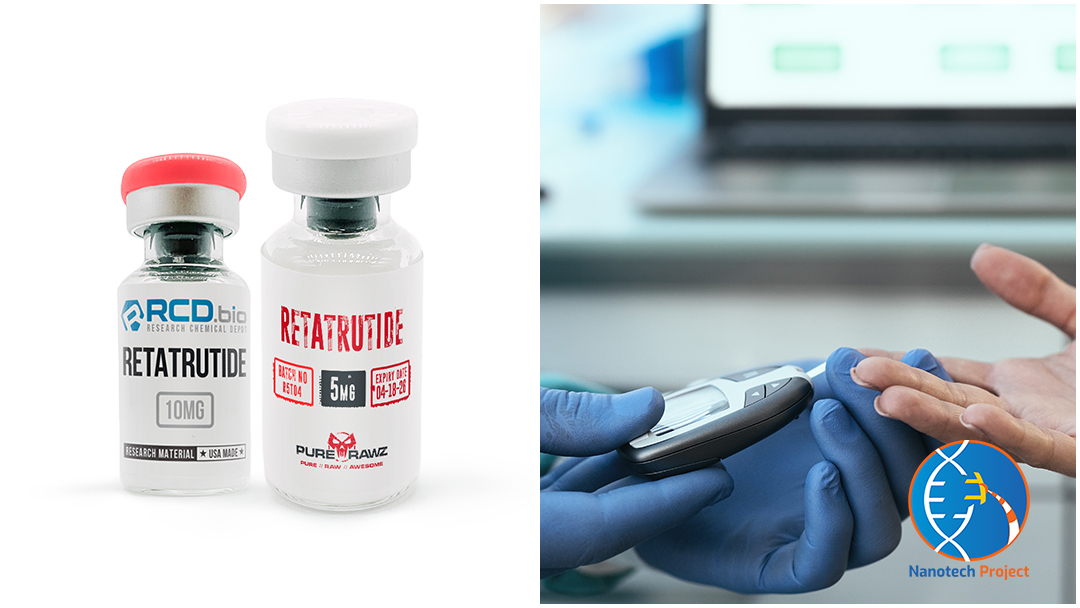Sick and tired of your belly fat, even after spending countless hours in the gym? Retatrutide is the ideal option for lowering your stubborn body mass, which we are pleased to introduce to you in this article.
Introduction
Retatrutide is an experimental drug for obesity and weight reduction developed by American pharmaceutical company Eli Lilly and Company. It is a GLP-1, GIP, and GCGR receptor 1 triple hormone receptor agonist. {R} In recent research at the Yale University School, the peptide achieved a mean weight loss of more than 24% in persons without diabetes who were obese or preobese (overweight). {R}
What is Retatrutide?
Retatrutide is a long-acting GLP-1 receptor agonist (GLP-1 RA) that is currently in late-stage clinical development for the treatment of type 2 diabetes and obesity. It is a modified version of the naturally occurring GLP-1 peptide, which has been engineered to have a longer half-life and greater potency.
Retatrutide – How Does it Work?
Retatrutide’s mechanism of action involves the activation of three hormone receptors: GLP-1, GIP, and GCGR. GLP-1 and GIP (glucose-dependent insulinotropic polypeptide) are incretin hormones that stimulate insulin secretion and reduce glucagon secretion, decreasing blood glucose levels.
1. GLP-1 Receptor Agonism:
GLP-1 is a hormone released by the intestine in response to food intake. It stimulates the release of insulin from the pancreas in a glucose-dependent manner, meaning it increases insulin secretion when blood sugar levels are elevated.
Retatrutide mimics this action of GLP-1 by activating its receptors. This activation enhances glucose-dependent insulin secretion, helping to lower blood sugar levels.{R}
2. GIP Receptor Agonism:
GIP is another hormone released by the intestine in response to food intake. It also stimulates insulin release from the pancreas but is less glucose-dependent compared to GLP-1.
Retatrutide also acts as a GIP receptor agonist.
3. GCCRs Receptor Agonism:
And lastly, the triple action agonism gets completed when GCGRs, the glucagon receptors, regulate glucose production in the liver. Retatrutide can enhance glucose metabolism, boost energy expenditure, and decrease hunger (thus reducing food intake) by activating these receptors. {R}
Retatrutide has shown promising results in (the placebo group) for weight loss and diabetes management. It can’t be emphasized enough that the peptide is most popular for its marvelous effects when used for weight loss and type 2 diabetes.
What is Type 2 Diabetes
Obesity, insufficient exercise, and poor diet are common lifestyle factors linked to type 2 diabetes. Obesity and weight gain are important risk factors for type 2 diabetes.
In type 2 diabetes, the pancreas may not generate enough insulin, and the body’s cells may grow resistant to the effects of insulin. As a result, high blood sugar levels are the result of type 2 diabetes.
Retatrutide has the ability to lower those unwanted elevated blood sugar levels without showing harmful effects associated with other medicines in this category.
Benefits of Retatrutide:
1. Effective blood sugar control:
Retatrutide has been shown to be effective in lowering blood sugar levels in patients with type 2 diabetes. While it’s critical for our health to maintain stable blood sugar levels, it’s especially important for those with diabetes or who are at high risk of getting the disease. {R}
2. Significant loss of body weight:
Retatrutide is potentially very effective in reducing body weight in patients with obesity. Losing body weight, especially when done in a healthy and sustainable manner, can have numerous benefits for overall health and well-being. {R}
3. Improved cardiometabolic risk factors:
Furthermore, retatrutide has proven to improve other cardiometabolic risk factors, such as blood pressure and cholesterol levels. Improving cardiometabolic risk factors can have a significant positive impact on cardiovascular and metabolic health. Cardiometabolic risk factors are a cluster of conditions that increase the risk of cardiovascular diseases (CVD) and metabolic disorders, such as type 2 diabetes. {R}
4. Convenient dosing:
Retatrutide is unique among GLP-1 RAs in that it is administered only once every two weeks. This makes it a more convenient option for patients than other GLP-1 RAs, which are typically administered once a week or once a day. {R}
5. Good tolerability:
Retatrutide is generally well-tolerated by patients, with the most common side effects being mild and gastrointestinal in nature. {R}
Additional Benefits
Treatment of NASH and Heart Failure
In addition to its potential for the treatment of type 2 diabetes and obesity, retatrutide is also being investigated for the treatment of other conditions, such as non-alcoholic steatohepatitis (NASH) and heart failure. NASH is a type of liver disease that is characterized by fat accumulation in the liver whereas heart failure is a condition in which the heart is unable to pump enough blood to meet the body’s needs. {R}
Retatrutide – Side Effects:
Retatrutide groups are associated with mild side effects, including gastrointestinal symptoms such as nausea, vomiting, diarrhea, and constipation. Other side effects may include headache, dizziness, fatigue, and injection site reactions. In very rare cases, it may cause pancreatitis or hypoglycemia.
Retatrutide – Is it Legal?
Retatrutide is not yet approved by the FDA or any other regulatory agency for commercial use. It is still undergoing clinical trials to determine its safety and efficacy. Therefore, before starting Retatrutide to treat obesity, it is recommended that you consult with a healthcare professional.
Retatrutide – Dosage
As mentioned earlier, the recommended dosage of Retatrutide is once every two weeks. As per authentic research in randomly assigned participants, the ideal body weight decreased dose-dependently with the use of 0.5 mg at 36 weeks. However, the initial dose should be set at 2mg to 4mg. {R}
Conclusion:
Retatrutide has the potential to be a valuable new treatment option for patients with type 2 diabetes and obesity. It is a long-acting GLP-1 RA that is effective in lowering blood sugar levels, reducing body weight, and improving other cardiometabolic risk factors. Retatrutide is also well-tolerated by patients, with the most common side effects being mild and gastrointestinal in nature.
Retatrutide is still under clinical trial, and once, available commercially, retatrutide has the potential to bring a valuable new treatment option for a number of conditions.
Where Can You Buy Retatrutide Online?
Pure Rawz and RCD.Bio is the best place to buy retatrutide. In order to be the best supplier of research chemicals, both online stores provide reference materials with every product they sell.


